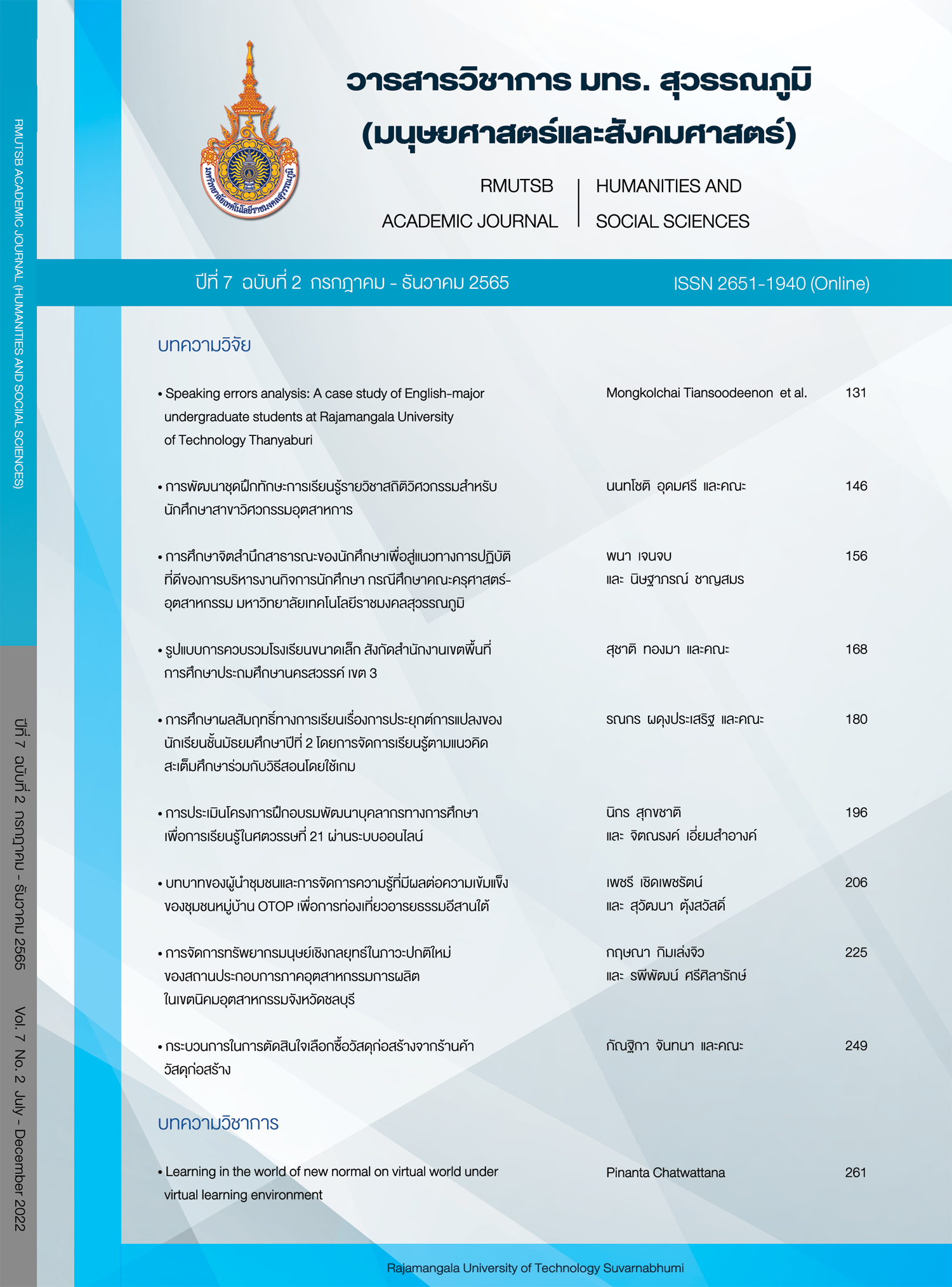Learning in the world of new normal on virtual world under virtual learning environment
Main Article Content
Abstract
This academic article mainly represents the issues and the guidelines related to learning in the world of new normal on virtual world, which can be applied in learning management in the digital world. This style of learning is also considered a new dimension of learning management without borders. Learning for learners in the world of new normal usually refers to learning in a virtual world in which learners can learn, no matter where they are, in a virtual learning environment. This way of learning can be implemented by making use of existing technologies or platforms, which enable a new form of learning without borders. Learning in the virtual world requires learning technologies and innovations to support instruction activities in a virtual learning environment and learning through a virtual community. The said technologies and innovations include augmented reality technology, virtual reality technology, mixed reality technology, extended reality technology, artificial intelligence technology, machine learning, etc. Such kind of learning also requires the integration of three elements to achieve optimum usability, i.e., hardware equipment, application software, and virtual learning environment. All of these elements enable learners to learn, do activities together, and interact with one another in a virtual world. In recent years, many forms of learning in the virtual world have been widely applied to education in order to promote lifelong learning, for example, learning through 3D animation, learning through virtual classrooms, practicing through virtual laboratories, searching for learning resources through virtual libraries or virtual museums, exploring exhibitions through virtual exhibitions, etc. Overall, the application of virtual technology to various fields results in a digital learning society that can respond to the digital transformation in the future. By this way, learners shall be promoted to learn and engage in interactive activities in an instant manner through mobile devices and 3D rendering devices under virtual learning environment.
Article Details

This work is licensed under a Creative Commons Attribution-NonCommercial-NoDerivatives 4.0 International License.
References
Alan, B., William, R., & Jeffrey, D. (2009). Developing virtual reality applications: Foundations of effective design. USA: Elsevier.
BitWiredBlog. (2013). 3D Glasses. Retrieved 2 July 2022, from https://bitwiredblog.files.wordpress.com/2013/05/
jpg
Boonlue, S. (2022). Metaverse for education: The connection between the metaverse with the real world of learning to create immersive learning. Academic Journal of North Bangkok University, 11(1), 9-16. (in Thai)
Boonphak, K. (2020). Learning management in the new normal era. Journal of Industrial Education, 20(2), A1-A6. (in Thai)
Chatwattana, P. (2021a). A MOOC system with self-directed learning in a digital university. Global Journal of Engineering Education, 23(2), 134-142. (in Thai)
Chatwattana, P. (2021b). Creative educational innovations based on experiential learning to enhance education of digital learners. Journal of Industrial Education, 20(1), 82-90.
Chatwattana, P., Kuntama, K., & Phadungthin, R. (2020). A 3D-interactive virtual classroom with a virtual learning environment. World Transactions on Engineering and Technology Education, 18(4), 387-392.
Chatwattana, P., & Phadungthin, R. (2019). Web-based virtual laboratory for the promotion of self-directed learning. Global Journal of Engineering Education, 21(2), 157-164.
Chookusol, C., & Wannapiroon, P. (2021). Virtual learning environment via smart coworking space. Journal of Education and Innovative Learning, 1(1), 97-110. (in Thai)
Damar, M. (2021). Metaverse shape of your life for future: A bibliometric snapshot. Journal of Metaverse, 1(1), 1-8.
Dillenbourg, P., Schneider, D. K., & Synteta, P. (2002). Virtual learning environments. Proceedings of the 3rd Hellenic Conference “Information & Communication Technologies in Education” (pp. 3-18). Athens Greece: Kastaniotis Editions.
EDUmetaverse. (2021). The education metaverse. Retrieved 2 July 2022, from https://www.youtube.com/watch?v=7
Qie819-Fvs
Greenstein, B. (2022). What’s the difference between VR/AR/MR/XR?. Retrieved 5 August 2022, from https://www.
epsilonxr.com/whats-the-difference-between-vr-ar-mr-xr/
Kerawalla, L., Luckin, R., Seljeflot, S., & Woolard, A. (2006). “Making it real”: Exploring the potential of augmented reality for teaching primary school science. Virtual Reality, 10(3), 163174.
KKI Official. (2021). Video tutorial virtual exhibition KKI 2021. Retrieved 5 July 2022, from https://www.youtube.com/
watch?v=-blPki7MOL4
Kumpai, K., Kusirirat, K., & Wata, A. (2020). Results of character design activities from playing computer games to enhance 3D character design skills in 3D animation courses. RMUTSB Academic Journal (Humanities and Social Sciences), 5(2), 269-282. (in Thai)
Labster. (2021). Labster chemistry virtual labs. Retrieved 5 July 2022, from https://www.youtube.com/watch? v=O
N3OjwVQhQ
Microsoft. (2022). HoloLens. Retrieved 2 July 2022, from https://www.microsoft.com
Office of the National Economic and Social Development Board. (2017). The twelfth national economic and social development plan (2017-2021). Retrieved 28 June 2022, from https://www.oneplanetnetwork.org/sites/default/
files/thailand_national_economic_and_social_development_plan_nesdp.pdf
Palaniappan, K., & Norah, M. N. (2022). Gamification strategy to support self-directed learning in an online learning environment. International Journal of Emerging Technologies in Learning, 17(3), 104-116.
Phoonsawat, G., Wanpeng, R., Homsai, S., & Pongsophon, P. (2022). Artificial intelligent and science teaching. Journal of Industrial Education, 21(1), C1-C8. (in Thai)
Sangsawang, T. (2021). Development of innovation and learning technology for vocational education. Journal of Industrial Education, 20(2), A1-A5. (in Thai)
Spatial. (2021). Spatial - The metaverse for creators, artists, exhibitions, and more. Retrieved 2 July 2022, from https://www.youtube.com/watch?v=tIJ2kT4_Rs4
Thanachawengsakul, N., & Thanyavinichakul, A. (2020). Education transformation into the role of higher education for local development. Journal of Industrial Education, 19(3), 131-142. (in Thai)
Wannapiroon, P. (2022). Innovation and intelligent technology for next normal education. Bangkok: MAC Education. (in Thai)
Wattanasin, W., Chatwattana, P., & Piriyasurawong, P. (2021). Engineering project-based learning using a virtual laboratory and mixed reality to enhance engineering and innovation skills. World Transactions on Engineering and Technology Education, 19(2), 232-237.
Yusny, R. (2017). Essential features of virtual learning environment system for English language teaching. Journal Pendidikan Aktual, 3(1), 1-14.


